SEO Statistics (original) (raw)
- 95% of search traffic goes to the first page of search results (Source)
- A one spot increase in rankings can increase CTR by 30.8% (Source)
- 49% of marketers cite organic search as providing the highest ROI (Source)
- Pages with the highest number of total backlinks usually rank best in Google (Source)
- URLs that include a keyword have a 45% higher CTR (Source)
- 80% is the average conversion rate of local searches (Source)
Improve your SEO strategy today by exploring these 100 SEO statistics.
Or, if you’re looking for professional help with SEO, partner with the best SEO company for small-to-midsized businesses. Browse our SEO services now! You can also call us at 888-601-5359 or contact us online to get started with your SEO goals!
- Search engine statistics
- Ranking statistics
- Backlink statistics
- Keyword statistics
- SEO industry statistics
- Local SEO statistics
- Voice SEO statistics
- SEO content statistics
- User behavior SEO statistics
Search engine statistics
- 91% of the search market is owned by Google (Source)
- 80% of Google’s search algorithm uses off-page factors — according to Google (Source)
- 2% of the search market is owned by Bing (Source)
- 1% of the search market is owned by Yahoo! (Source)
- 1% of the search market is owned by Baidu (Source)
- 45% of the search market is owned by DuckDuckGo (Source)
- 1+ billion people use Google every month (Source)
- Google processes more than 3.5 billion searches each day (Source)
- Google processes 70,000 searches per second — that’s 5.8 billion per day or 2 trillion per year (Source)
- Google uses more than 200 ranking factors for its search algorithm (Source)
See more Google Search statistics
Ranking statistics
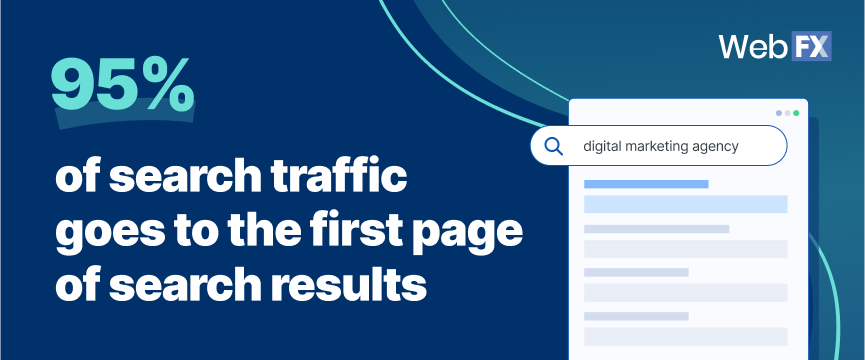
- The first organic search result is 10x more likely to earn a click than #10 organic search result (Source)
- SEO generates 1000% more traffic than social media (Source)
- The buying cycle is now nine days longer than in 2015 (Source)
- Google image searches account for 62.6% of all searches on Google Web Search (Source)
- A one spot increase in rankings can increase CTR by 30.8% (Source)
- Google search results display around 8 pages on the first page (Source)
- 95% of search traffic goes to the first page of search results (Source)
- 95% of new pages do not reach the first page of search results for the first year (Source)
- 90% of pages receive zero organic traffic (Source)
- 89% marketers say SEO successful (Source)
- 85% retailers feel SEO and paid search are most effective for getting new customers (Source)
- 78% of Google searchers click on something from page two (Source)
- 74% small-to-midsized businesses will invest in SEO by 2017 (Source)
- 71% of clicks on Google search results go to the first page (Source)
- 70% of searches use more than three words (Source)
- 68% of clicks go to the first five results on Google (Source)
- 62% of B2B marketers see SEO algorithms as important to them (Source)
- 61% of CMOs view search engines as an effective marketing channel (Source)
- 54% of product searches happen on Amazon.com (Source)
- 51% of website traffic is driven by organic search (Source)
- 49% of marketers cite organic search as providing the highest ROI (Source)
- 44% of businesses use SEO (Source)
- 40% of revenue is driven by organic traffic (Source)
- 33% of small-to-midsized businesses have optimized websites (Source)
- 33% search traffic goes to the first organic search result on Google (Source)
- 26% of clicks go to the first search result when a featured snippet does not exist (Source)
- 22% of pages created in the last year rank on the first page of search results (Source)
- 19% is the average CTR for the first position on Google (Source)
- 19% of clicks go to the first search result after the featured snippet (Source)
- 12% of searches generate featured snippets in the search results (Source)
- 10% is the average CTR for the second position on Google (Source)
- 8% is how much the first search result’s CTR drops when there is a featured snippet (Source)
- 6% is the average close rate of SEO — that’s eight times higher than traditional marketing (Source)
- 6% of clicks go to the featured snippet (Source)
- 6% of clicks on search results go to the second page (Source)
- 6% of clicks on Google search results go to the second and third page (Source)
Backlink statistics
- Link builders using social media build 22% more links than those who don’t. (Source)
- Pages with the highest number of total backlinks usually rank best in Google (Source)
- The top result in Google has an average of 3.8x more backlinks than those in second to tenth place (Source)
- 66% of pages don’t have a backlink (Source)
- 41% of marketers think link building is the most difficult part of SEO (Source)
- 26% of pages have links from less than three websites (Source)
Keyword statistics
- URLs that include a keyword have a 45% higher CTR (Source)
- 50% of searches use four or more words (Source)
- 39% of marketers think keyword research is the most difficult part of SEO (Source)
- 19% of featured snippets triggered are for question search queries (Source)
- 17% of featured snippets triggered are for search queries with prepositions (Source)
- 8% of searches get worded as questions (Source)
SEO industry statistics
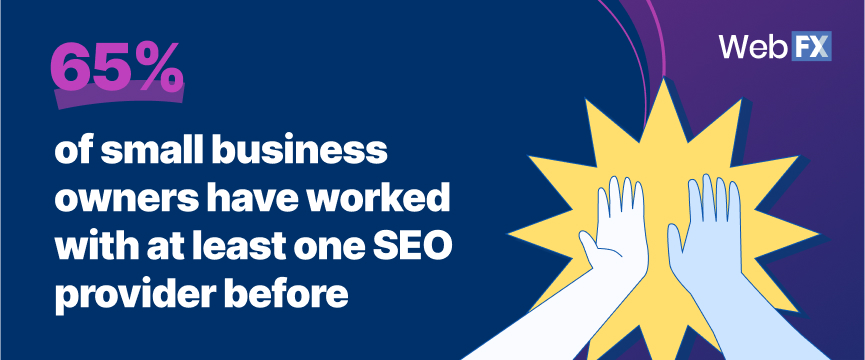
- 65% of small business owners have worked with at least one SEO provider before (Source)
- 30% of clients would recommend their current SEO provider to a friend or colleague (Source)
- 14% of U.S. small businesses spend $5000 per year on SEO services (Source)
- 2% of U.S. small businesses spend over $25,000 per year on SEO services (Source)
- $497.16 is the average amount U.S. small businesses spend on SEO services per month (Source)
- $361 is the average cost to purchase a backlink (Source)
- Businesses that spent less than 500permonthwere75500 per month were 75% more likely to be dissatisfied than those that invested at least 500permonthwere75500 per month on SEO (Source)
- Businesses that spent over 500permonthonSEOserviceswere53.3500 per month on SEO services were 53.3% more likely to be “extremely satisfied” compared to those that spent less than 500permonthonSEOserviceswere53.3500 per month (Source)
- Businesses spend around $79 billion on SEO services (Source)
Local SEO statistics
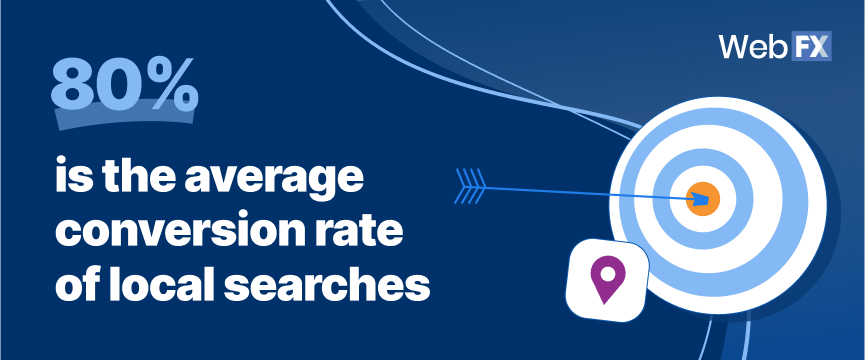
- 80% is the average conversion rate of local searches (Source)
- 28% of local searches results in a purchase (Source)
- 54% of the Internet’s traffic comes from mobile devices (Source)
- 46% of Google searches have a local search intent (Source)
- “Near me” searches have increased by more than 500% percent(Source)
Voice SEO statistics
- 75% of voice-enabled speaker owners use voice search weekly to find local companies near them (Source)
- 71% of people use voice assistants to ask for directions (Source)
- 56% of people use voice assistants to find somewhere to eat (Source)
- 55% of people use voice search (Source)
- 52% of people use voice search while driving (Source)
- 48% of the voice assistant market is owned by Apple’s Siri (Source)
- 46% of people use voice assistants (Source)
- 20% of searches happen via voice (Source)
- Google’s speech recognition software recognizes 100+ languages (Source)
SEO content statistics
- 61% of companies outsource content marketing efforts (Source)
- 57% of marketing executives view content development as the most effective SEO strategy (Source)
- 47% of users interact with three to five pieces of content before contacting a business (Source)
- 1890 is the average word count for a page that ranks on the first page of search results (Source)
User behavior SEO statistics
- 93% of online experiences begin with a search engine (Source)
- 80% of users start their product research online (Source)
- 75% of clicks go to the top three search results (Source)
- 75% of users visit the first page of search results only (Source)
- 71% of B2B clients start product research with search engines (Source)
- 70-80% of users focus on organic search results vs. paid listings (Source)
- Over 70% of people research company on web before deciding to buy or visit (Source)
- 51% of users discover a new company or product after a search (Source)
- 25% of users visit the second page of search results (Source)
- 21% of users click on multiple search results (Source)
- The average user conducts 3-4 searches per day or 1095 to 1460 searches per year (Source)
- The average search session is under 1 minute (Source)
- Long-tail searches (or searches with three or more words) have a 3-5% higher CTR (Source)
- The average B2B user conducts 12 searches before interacting with a website (Source)
- The average user visits around three pages on sites they visit from search results (Source)
FAQs about SEO statistics for organic search
Companies that invest in digital marketing have tons of choices when it comes to strategies. You have video marketing, content marketing, social media marketing, and more. A fundamental part of those approaches is SEO, which relies on organic search.
That’s why it’s critical to convey the role of organic search, which you can show with these SEO statistics:
1. How much traffic can organic search drive to my website?
Today, organic search drives more than 50 percent of all website traffic. That’s more than paid and social combined. For reference, paid search only drives 10 percent of site traffic, while social takes credit for five percent of website traffic.
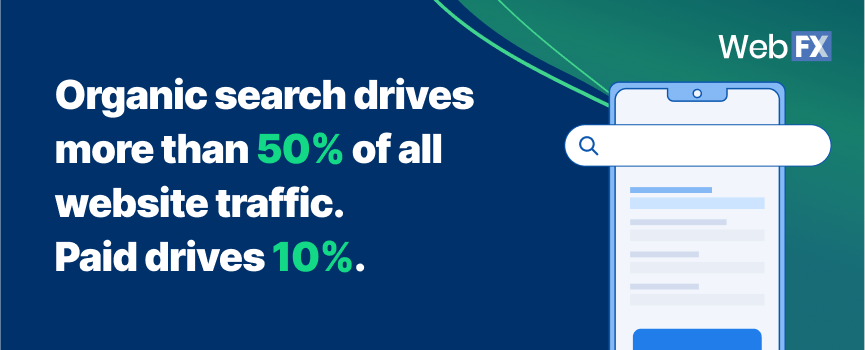
It’s worth mentioning that PPC services are still a valuable tool in digital marketing. While you may drive less traffic to your site via PPC, that traffic carries immense value because you’re targeting users ready to buy your product.
Companies can’t ignore the tremendous amount of traffic generated by organic search, though. Over half of your site’s traffic comes from organic search, providing your business immediate access to your target audience. Overlook SEO, and you’re not only turning away revenue but giving it away to competitors.
2. Are users more likely to click on paid ads, rather than organic search results?
In today’s digital world, users prefer organic search results over paid ads. In a recent study, for example, researchers discovered that 70 to 80 percent of users focus on organic search results, ignoring paid listings.
Why? A few reasons:
- Ad formats: For many users, ads intrude on their browsing experience — more than 70 percent of people, for instance, cite pop-up ads as their least favorite advertisement. To improve their online experience, users turn to ad blockers.
- Ad blockers: Around 25 percent of Internet users browse the web with an ad blocker. An ad blocker often works as an extension on an Internet browser, like Chrome. They prevent users from seeing any advertisements, only showcasing organic search results.
- Ad personalization: While more than 70 percent of users prefer ads personalized to their interests, not every user receives ads tailored to them. It’s another reason why users install ad blockers, prioritizing organic search results over paid ones.
It’s important to highlight that users aren’t immune to paid advertisements. Their decisions often depend on their mindset. When people are ready to purchase a product, for example, almost 65 percent click on ads. That’s why smart PPC campaigns focus on users looking to buy, rather than research a product or service.
While a paid advertisement can propel your company’s website to the top of search results, it doesn’t offer the long-term value, or cost savings, of a top ranking in organic search results. With an improved ranking in organic search results, your business can gain valuable traffic, conversions, and revenue.
3. How much revenue can SEO generate?
No matter how much you invest in digital marketing, you want to see a return on investment (ROI). In comparison to other digital marketing strategies, SEO delivers results over time and requires continuous investment. For a lot of in-house marketing teams, these requirements make SEO difficult to pitch.
Organic traffic, however, can capture more than 40 percent of your company’s revenue.
If your company’s annual revenue is 500,000,forexample,then500,000, for example, then 500,000,forexample,then200,000 of it comes from organic traffic. Depending on your business, industry, and products, this percentage may vary. However, you can use it as a reference point when pitching company leaders.
FAQs about SEO statistics for search engines
Before exploring how SEO influences user behavior, it’s critical to understand where users search. When you recognize the favorite search engines of your target audience, as well as the algorithms powering those search engines, you can build a competitive SEO strategy.
Check out these SEO statistics on search engines:
1. How many people use search engines?
When people go online to find a new product, company, or service, they start with a search. Research shows that around 93 percent of online experiences begin with a search engine like Google, Yahoo!, or Bing. It’s rare for users to know what they want. They may have an idea, but they need a search engine to guide them.
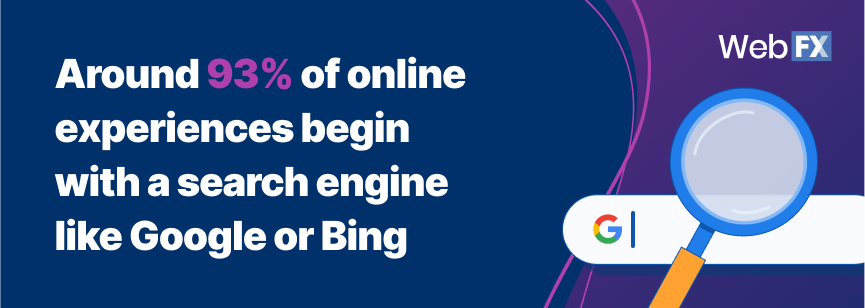
If your company doesn’t appear in search results, how will users find you? In most cases, they won’t.
Users will, however, find your competitors and do business with them. Even if you offer a better product and service, it won’t matter because, from a user’s perspective, you don’t exist. If you want to become an option for consumers, then you need to make SEO a priority.
2. Which search engine is the most popular?
If you rely on Google for search, you’re not alone. The search engine dominates the industry, owning more than 70 percent of the search engine market. That’s why many companies tailor their SEO strategies to Google versus Yahoo! or Bing.
In comparison to Google, Bing claims 4.5 percent of the market and Yahoo! 2.5 percent.
Now, if your business targets international markets, like China, you may focus on a different search engine. Baidu, for example, is the leading search engine for users in China. That’s why Baidu holds almost 15 percent of the search engine market share, second to Google.
3. How many people use Google for search?
More than one billion people use Google every month.
Chrome, Google’s designated web browser, maintains more than one billion monthly users on desktop and more than 400 million monthly users on mobile. This fact demonstrates the continued role of Google in search.
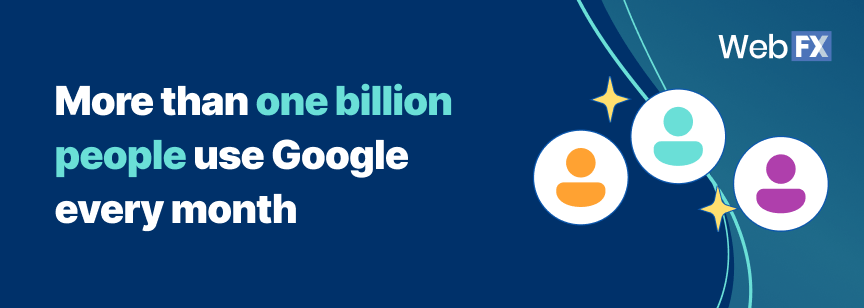
It’s a search engine that consumers and businesses use when looking for a new product, service, or brand, which is why many companies prioritize Google in their SEO strategy. It offers access to a larger audience, which can lead to more traffic, conversions, and sales.
4. How does Google rank search results?
If your business focuses on Google in your SEO plan, it’s critical to understand how Google ranks search results. With insight into Google’s search algorithm, your team or SEO agency can develop a data-driven strategy for improving your visibility in search results.
Google relies on more than 200 ranking factors, including:
- Domain age
- Website usability
- Page speed
- Grammar or spelling errors
- Publishing frequency
According to Google, almost 80 percent of its search engine algorithm relies on off-page factors. These are elements outside your company’s control. A backlink, for example, is an off-page factor. It’s when another website links to a relevant page on your site, like a blog post.
Due to the value of off-page factors, as well as their difficulty to influence, many businesses struggle with off-page SEO. Avoiding off-page SEO, however, can have a significant impact on your rankings in search results. Improve your strategy with off-page SEO or see how an SEO agency can help.
5. What kind of close rate can companies expect with SEO?
SEO offers a 14.6 percent close rate. That’s embarrassingly low, right?
Compare it to the average close rate of traditional marketing, however, and it’s impressive. In fact, it’s eight times the close rate of traditional marketing, which sits at 1.7 percent. For reference, close rate refers to the percentage of leads that become clients.
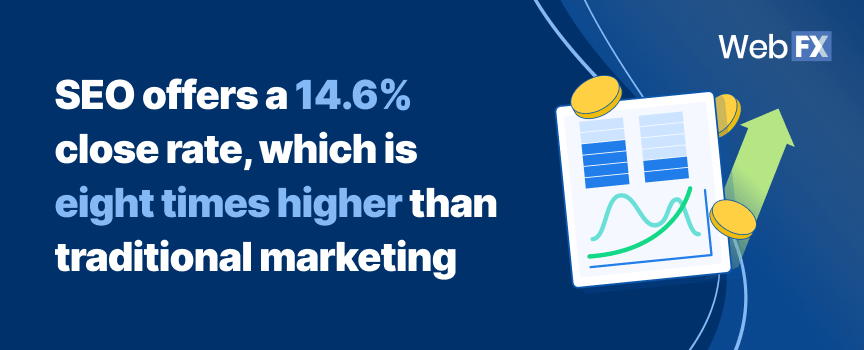
If your business can improve its close rate, why wouldn’t you?
With a better close rate, your company can build its client base, grow its revenue, and increase its market share. That kind of growth positions your business to become an industry leader. It also helps your company achieve some significant milestones, like opening a new location, expanding a team, or launching a new product.
FAQs about SEO statistics for user behavior
For your SEO strategy to succeed, it’s critical to understand user behavior. Whether your business manages your SEO in-house or partners with an agency, learning about the behavior of users in your target audience can improve the results of your SEO.
Learn more about the behavior of users online with these SEO statistics:
1. How do people search on Google and other search engines?
With 50 percent of searches using four or more words, it’s clear that people prefer long-tail keywords. Why?
A long-tail keyword, which includes three or more words, focuses on a specific intent. Compare the search “long white winter coat” to “winter coat,” for example. A winter coat includes a ton of different options, while a long white winter coat features a few helpful details about what a person wants.
Your business can use this user behavior to your advantage.
For instance, you can improve your SEO strategy by focusing on long-tail keywords. Even better, you can make user intent a priority, researching what users want and creating content around those expectations. With this revised approach, you can rank for keywords that drive valuable traffic to your site.
2. How many users go to the second page of search results?
According to multiple studies, only 25 percent of users go to the second page of search results.
That means 75 percent of users stick to the first page of search results.
If your website ranks on the second page of search results for a keyword with 1000 monthly searches, you’re only reaching 250 users. The remaining 750 users find what they need on the first page. Even if 250 users visit the second page, you have no guarantee they will click on your website.
For companies that want to succeed in today’s marketplace, it’s critical to adopt an SEO strategy. It’s imperative, however, to develop and maintain a plan that focuses on page-one rankings. If not, you give away valuable traffic, leads, and revenue to your competitors.
3. Do users find new companies via search?
Yes!
With more than 90 percent of online experiences starting with search engines, and 80 percent of users beginning their product research online, SEO provides your company the chance to connect with consumers that haven’t committed to a business or product.
Studies show that more than 50 percent of users discover a new company or product after a search.
For many organizations, especially small-to-midsize businesses (SMBs), this SEO statistic demonstrates a significant benefit of SEO. With SEO, your company can rank in relevant, high-value search results for users looking for your products or services.
It’s a feature that allows your business to connect with and convert top-of-the-funnel shoppers.
FAQs about SEO statistics for local SEO
If you’re a local business, SEO can have a massive impact on your short- and long-term success. It can help users discover and learn about your company, as well as visit it. Those actions translate to real results, from more visits during your slow season to more revenue for your company.
Get more insight into local SEO with these statistics:
1. What percentage of local searches convert?
A conversion can range from an in-store visit to an email sign-up.

While conversion rates vary for non-local searches, local searches maintain an average conversion rate of 80 percent. That’s massive, emphasizing that local searches often focus on taking an action, like finding somewhere to eat.
2. Do local searches result in purchases?
Today, 28 percent of local searches result in a purchase. It’s a compelling SEO statistic that reinforces how local searches often have a buying intent. People want to find a restaurant, amusement park, bakery, or boutique near them quickly.
Invest in a local SEO strategy, and your company can connect with this segment of your target audience. This investment can result in significant gains for your business. A restaurant, for instance, may earn more reservations while a mattress store may see more purchases.
3. Is local search a temporary trend?
While some search trends may seem like a fad, local search is here to stay. According to Google, searches with the phrase, “near me,” have increased by more than 500 percent in the past few years. People want to find businesses near them and are transitioning away from specifying their specific area.
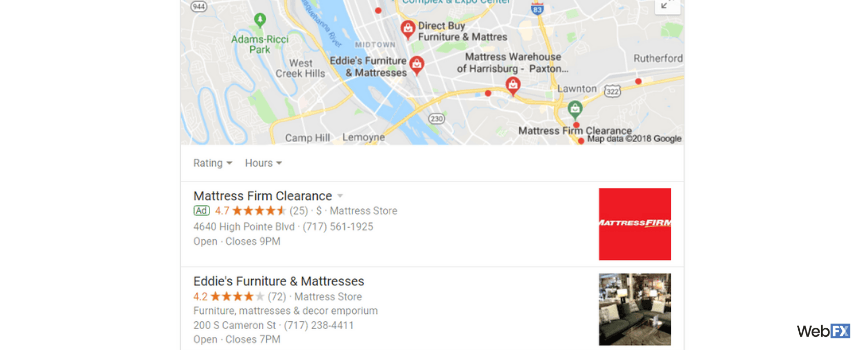
That’s why it’s imperative for businesses to create a Google Business Profile listing. With a Google Business Profile, your company provides all the information users want. Via GBP, users can see your company’s address, hours, services, contact information, and more.
Even better, Google can quickly serve your Google Business Profile in search results.
4. What percentage of searches have a local intent?
With more than 50 percent of the Internet’s traffic coming from mobile devices, it’s not surprising that 46 percent of Google searches have a local search intent. It’s a rising trend that indicates users are searching on-the-go for what they need.
It’s also an SEO statistic that demonstrates why SEO matters to local businesses. With SEO, you can direct valuable traffic to your store. Plus, you can expand your marketing efforts, generating sales from not only word-of-mouth recommendations but also search engines like Google.
FAQs about SEO statistics for voice search SEO
Today, 46 percent of people use voice assistants, like Amazon Echo, Google Assistant, or Siri. As voice search use increases, businesses are adopting a proactive approach to voice search SEO. They’re optimizing their content now, versus later, for voice search users.
Learn more about voice search and its value with these SEO statistics:
1. How many people use voice search?
More than 55 percent of people use voice search, specifically to find local businesses. Even better, more than 75 percent of voice-enabled speaker owners use voice search each week to discover a local company near them. Invest in voice search now, and your business can start reaping the benefits of these searches.
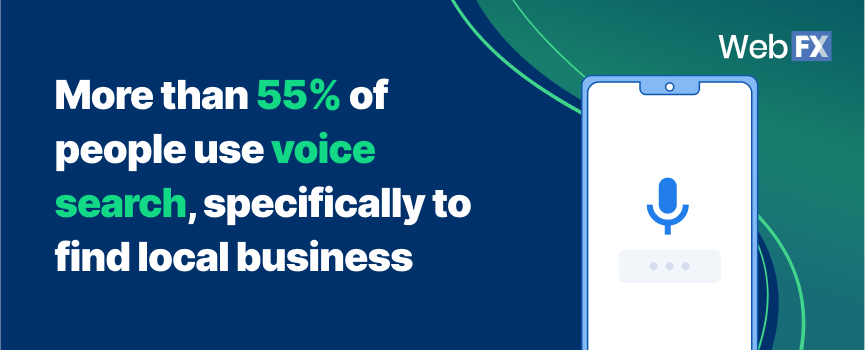
2. How many voice searches happen each month?
It’s hard to imagine that more than one billion voice searches happen each month, but they do. That’s why your company doesn’t want to ignore voice search. If you do, you’re overlooking a valuable portion of your target audience.
You also create an opportunity for your competitors. If they optimize for voice search and you don’t, it’s easy for them to reach and convert your target audience, which costs your company revenue. It also threatens your future growth as well as the long-term success of your business.
3. What percentage of searches happen by voice?
In 2024, voice search will account for 60 percent of all searches. It’s a compelling SEO statistic, emphasizing that if you exclude voice search from your SEO strategy, you risk alienating half of your target audience. If your company wants to succeed after 2024, you need a voice SEO strategy.
With voice search SEO, you maximize your online reach. A voice search SEO strategy also ensures your company maintains its competitiveness in the marketplace. Plus, you capitalize on competitors that overlook this increasingly valuable strategy.
Want to learn more about using SEO?
Whether you’re familiar or new to SEO, WebFX can help. With more than 28 years of experience, plus a client recommendation score that’s 488% higher than the industry average, we are the trusted partner for companies worldwide.
We also offer the award-winning SEO services you need, including:
- SEO audit services
- SEO management services
- Local SEO services
- Voice search SEO services
- Ecommerce SEO services
- Enterprise SEO services
Learn how we can improve your SEO strategy by contacting us online or calling us at 888-601-5359 today!